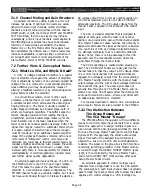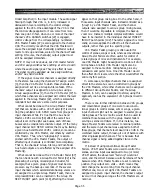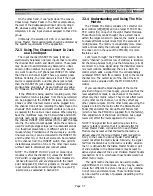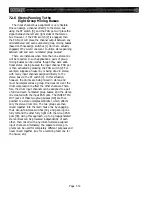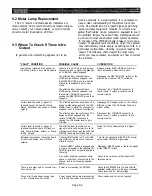
into the corresponding matrix channels, and fed to the
house sound system which is driven by the matrix
outputs.
A related use for the MTRX SUB IN connectors is to
inject a test signal for speaker setup and testing. While
the PM4000 test oscillator can be assigned to the Group
or Stereo busses, which, in turn, feed the matrix, it is
likely that the Group and Stereo Master Faders will not
be set at nominal levels for the show. Assuming the
speaker system is fed from the matrix outputs, and
assuming the sound check is already completed and the
Group and Stereo Masters are set at the desired levels,
one would not want to reset those Masters just to run a
test signal to the speakers. Instead, you can run a patch
cable from the OSC OUT connector [135] to one MTRX
SUB IN connector [110], set the MTRX SUB IN control
[28] at nominal (#10), adjust the MTRX MASTER
control [31] as required, and check the speaker system.
You can then re-patch the OSC OUT cable to the next
MTRX SUB IN, and test the next channel of power
amps and speakers, until all amplifier/speaker circuits
have been tested. This is one way to get pink noise into
the system for spectrum analysis and graphic EQ
adjustment.
If you need “one more group” beyond the eight
Groups and the Stereo bus, you can use one or two of
the Aux Send busses for that group. You can then
connect a patch cable from the corresponding AUX
SEND OUT connector(s) to the MTRX SUB IN
connector(s), using a “Y” or splitter if necessary to feed
more than one matrix channel from a single Aux bus.
These AUX SEND Master controls then serve as group
masters.
A more expensive, but more elegant approach to
using “Y” cables is to use an external distribution
amplifier (D.A.) which provides separate, buffered
outputs from a single input. The D.A. outputs could
then be connected to the various MTRX SUB IN
S
.
7.2.4.4 Use of the Matrix to
Pre-Mix Scenes
We believe that the VCA capability of the PM4000,
along with the master mute system described in the
following section, together provide a most elegant
means to pre-mix different “scenes,” whether the
application is a theatrical production or subsequent
“sets” during a live concert. The mix matrix does,
however, provide an alternate means to pre-mix scenes.
Let's assume the house sound system is a simple
one-zone, stereo system. You can use the first two mix
matrix channels to create the desired balance of Groups
1-8 and of the Stereo mix, blending these ten sources
into two MTRX MASTER controlled outputs that are
ideally suited to the first scene. You can use the next
two mix matrix channels to create a differently bal-
anced mix for the next scene, and so forth. The only
“trick”, if you think about it, is that each pair of matrix
outputs must still feed the same pair of power amplifier
and speaker channels. This may not be a problem if you
have time to move the two output cables from one pair
of matrix outputs to the next in between scenes. Alter-
nately, you could use an external mixer (such as a
Yamaha M206) to mix the several matrix outputs
together for feeding the amplifier... a more expensive
approach, but easier to implement.
CAUTION: Definitely check such a system
prior to show time to be sure there are no
ground loop currents or other problems
that would cause audible pops when mov-
ing cables with live power amps.
7.2.5 Understanding and Use of
The Master Mute Function.
Each input channel is provided with eight MUTE
Assign switches [23]. When one of these switches is
engaged on a given input channel, that channel be-
comes subject to control by the correspondingly num-
bered MUTE MASTER switch [76]. Specifically, when
the MUTE MASTER switch is engaged, then the
assigned input channel(s) turn Off (assuming they had
been turned On in the first place). What this means is
that any assortment of input channels can be pre-set to
turn off when one or more of the MUTE MASTER
switches is engaged (or to turn on when the MUTE
MASTER switch is released). this is useful in just about
every conceivable application.
In a concert, an entire group of mics can be muted
when the instruments and/or vocalists are not using
them. The input channel faders and other mix controls
can all be left at their previously established settings,
and only one MUTE MASTER switch need be engaged
to keep these mics (or line level sources) from contribut-
ing to the console output. Then, at the precisely re-
quired moment, that group of channels can be brought
into the mix “on cue” by releasing the MUTE MASTER
switch.
For a theatrical presentation, different scenes can be
un-muted as required, keeping the number of open mics
at a minimum, which reduces the tendency for feedback
with distant mics in a live sound reinforcement system.
For recording, a group of inputs which are primarily
used for solo performances can be kept muted until the
moment they are needed, thus minimizing noise. For a
church, the choir mics can be kept muted until the
Page 7-10
Summary of Contents for PM4000
Page 1: ...PROFESSIONAL AUDIO MIXING CONSOLE PM4000 OPERATING MANUAL YAMAHA ...
Page 2: ...PM4000 OPERATING MANUAL ...
Page 7: ...Section 1 Introduction ...
Page 11: ...Section 2 Brief Operating Instruction ...
Page 47: ...Section 3 Specifications ...
Page 51: ...Dimensional Drawings PM4000 Console all versions Page 3 4 ...
Page 52: ...Page 3 5 ...
Page 53: ...Page 3 6 PM4000 Console Rear Profiles ...
Page 54: ...Module Block Diagrams See back of the manual for overall system block diagram Page 3 7 ...
Page 55: ...Page 3 8 ...
Page 56: ...Page 3 9 ...
Page 57: ...Page 3 10 ...
Page 58: ...Page 3 11 ...
Page 59: ...Page 3 12 ...
Page 60: ...Section 4 Installation Notes ...
Page 72: ...Figure 4 13 Cables For Use With Balanced Sources Page 4 12 ...
Page 79: ...SECTION 5 Gain Structure and Levels ...
Page 82: ...Figure 5 1 Dynamic Range and Headroom in Sound Systems Page 5 3 ...
Page 86: ...Section 6 Optional Functions ...
Page 106: ...Section 7 Operating Notes and Hints ...
Page 119: ...Section 8 Applications ...
Page 127: ...Section 9 Maintenance ...
Page 131: ......
Page 132: ...YAMAHA VN02300 ...









